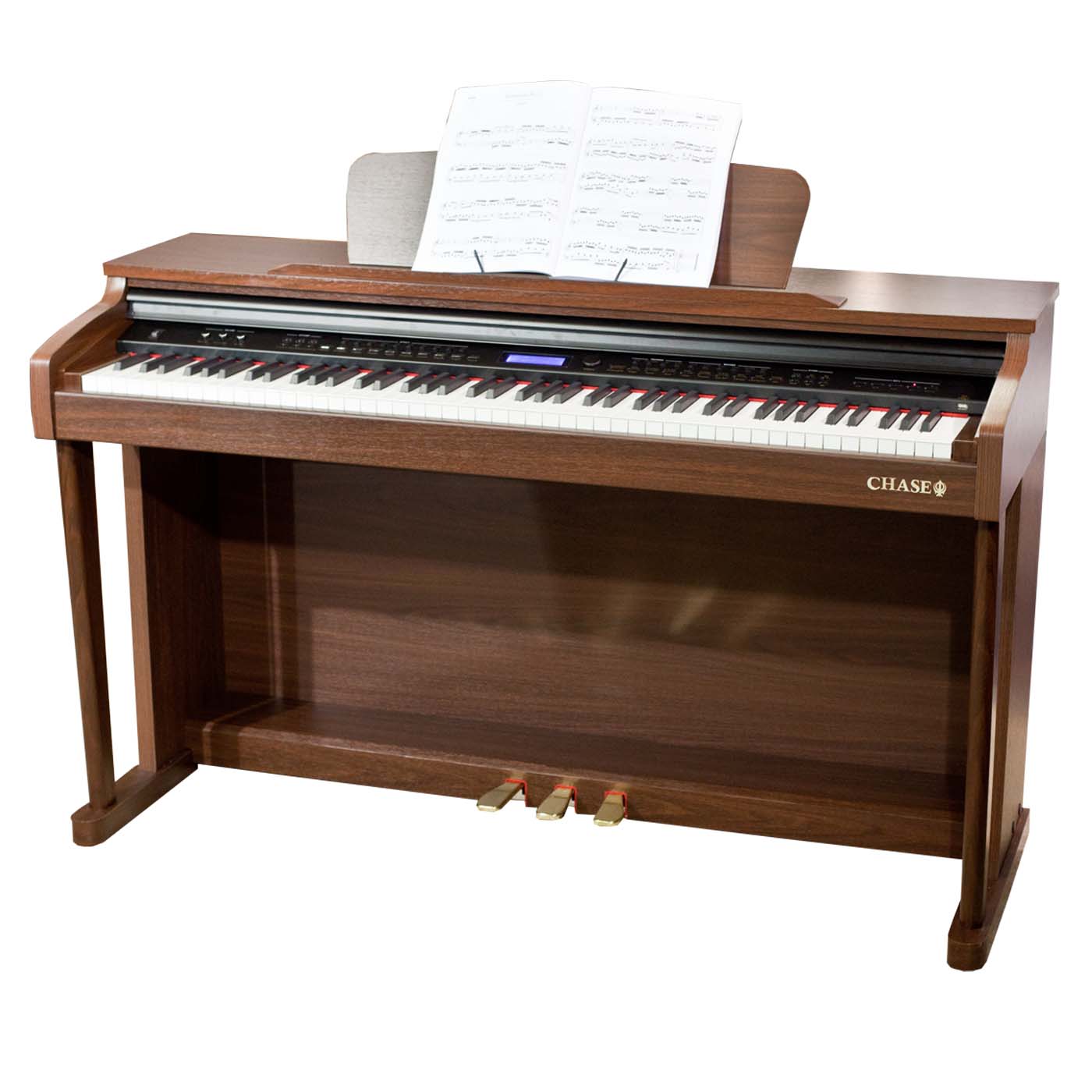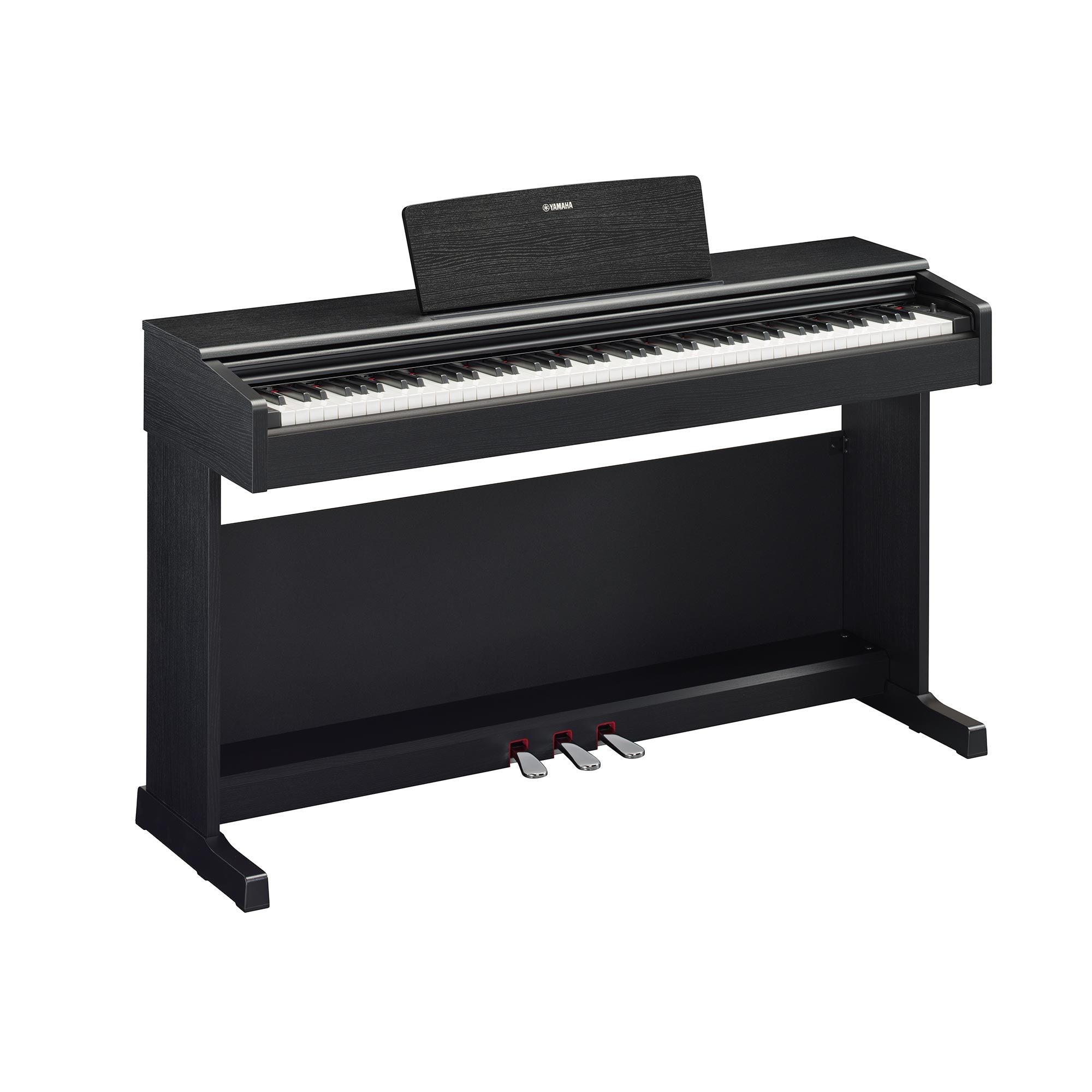Digital pianos are electronic instruments designed to replicate the sound and feel of acoustic pianos. They offer a range of sounds and features, in a more portable form.
Digital pianos provide a practical alternative to traditional acoustic pianos for both beginners and seasoned pianists. With weighted keys that mimic the touch of real piano keys, these instruments often include various sound options such as grand piano, electric piano, and organ.
Their appeal includes volume control and headphone connectivity, making them ideal for quiet practice sessions. Players benefit from the ability to record performances, use built-in metronomes and access interactive learning tools. Compact and requiring minimal maintenance, digital pianos fit well in modern homes and educational settings. They serve as a cost-effective solution for those looking to enjoy the piano experience without the space or budget for an acoustic piano.

Credit: en.wikipedia.org
Evolution From Acoustic To Digital Pianos
The journey from the rich, reverberating tones of acoustic pianos to the sleek, versatile digital pianos we know today tells a tale of technological triumph. This evolution reflects both the love for time-honored music and a leap towards futuristic sound reproduction. Let’s explore how piano technology has transformed over time.
Early Beginnings Of Keyboard Instruments
The first keyboards emerged centuries ago. They started as simple instruments. Names like clavichords and harpsichords may sound unfamiliar today, but they set the stage. The revered grand piano came next.
- Clavichord – a soft, subtle instrument with strings and metal blades.
- Harpsichord – known for its twangy, precise tones, plucking strings inside.
- Grand Piano – an engineering marvel, beloved for its dynamic range.
Each of these keyboards paved the way for the modern piano. The grand piano, especially, set a standard in music that still resonates today.
Advancements In Digital Sound
In the late 20th century, a new wave hit the music world: digital sound. As a result of this, digital pianos came to life.
| Year | Advancement |
|---|---|
| 1960s | Early electronic keyboards mimic piano sounds. |
| 1980s | Digital pianos with weighted keys emerge. |
| 2000s | High-quality sampling improves sound authenticity. |
| Today | Hybrid models offer a mix of acoustic and digital features. |
Musicians now enjoy a range of sounds from a single instrument. Whether it’s emulating a grand piano or experimenting with synthesized melodies, digital pianos make it possible.

Credit: usa.yamaha.com
Anatomy Of A Digital Piano
A digital piano is an innovative musical instrument that emulates the sound and feel of an acoustic piano. But what really lies within this modern musical marvel? Let us take a journey through the Anatomy of a Digital Piano to understand its inner workings. This knowledge not only enriches your understanding but also guides you when choosing the perfect instrument to match your musical aspirations.
Key Components And Action
The heart of a digital piano lies in its key components and action. These two elements work together to give pianists the traditional tactile sensation akin to an acoustic piano.
- Keys: Digital pianos typically have 88 weighted keys to mirror the keyboard of an acoustic piano.
- Weighting and Touch Sensitivity: The keys have a weighted feel, with touch sensitivity that responds to the force of your playing.
- Sensors: Beneath each key, sensors detect the movement and send signals to generate sound.
All these components ensure players experience a dynamic and expressive performance, similar to that of a traditional piano.
Speakers And Sound Projection
The power of a digital piano’s sound significantly depends on its speakers and sound projection system. High-quality audio components can make a vast difference in your musical journey by delivering clear and resonant tones.
| Component | Function |
|---|---|
| Speakers | They convert electronic signals into audible sound, enveloping the room with music. |
| Amplifiers | These boost the sound signal to provide a powerful output without distortion. |
From deep, rich bass to sparkling highs, the speaker system in a digital piano can impressively replicate the sonorous quality of its acoustic counterpart.
Understanding these key aspects of a digital piano allows prospective players and enthusiasts alike to appreciate the intricate technology that goes into creating the sounds we all love. A well-designed digital piano not only sounds fantastic but also provides a satisfying playing experience that rivals that of a traditional piano.
Varieties And Models
Exploring the world of digital pianos reveals a dazzling array of varieties and models. Each is crafted to cater to different needs, skills, and environments. From the comfort of a living room to the thrill of a stage performance, digital pianos have evolved to suit every musical occasion.
Console Vs. Stage Pianos
Let’s start with a common dilemma: choosing between a console piano and a stage piano.
- Console Pianos are designed to mirror the look and feel of traditional acoustic pianos. They often include built-in stands and pedal systems. These pianos suit homes and music schools.
- Stage Pianos, on the other hand, are lightweight and portable. They focus on functionality and adaptability, perfect for traveling musicians and live performances.
Here’s a comparison to help you visualize the differences:
| Feature | Console Piano | Stage Piano |
|---|---|---|
| Design | Traditional, with cabinet | Compact, portable |
| Weight | Heavier, stationary | Lighter, easy to move |
| Pedals | Often included | Separate, optional |
Specialized Features And Accessories
Digital pianos also come with specialized features and accessories that enhance playability and performance.
- Weighted Keys: Imitates the touch and feel of acoustic piano keys.
- Multi-track Recording: Allows recording and layering of multiple tracks.
- Sound Libraries: Offers a variety of instrument voices and sound effects.
Accessories can further expand the capabilities of your digital piano:
- Piano Stools: Provide comfortable seating for prolonged practice.
- Headphones: Enable quiet practice sessions.
- Sustain Pedals: Offer acoustic piano sustain effects.

Credit: kawaius.com
Technological Integration
Digital pianos bridge the gap between traditional craftsmanship and modern innovation. These instruments carry the soulful sound of an acoustic piano while boasting features that only technology can provide. With a myriad of functions, digital pianos stand at the forefront of musical evolution.
Midi Compatibility And Connectivity
Musical Instrument Digital Interface (MIDI) remains a core feature in digital pianos. It allows these pianos to communicate with computers and other electronic devices. Users can create and edit music with ease, making it an ideal tool for composers and producers.
- USB ports to connect to computers and tablets
- Bluetooth for wireless connections to apps and software
- Traditional MIDI ports to interface with older equipment
Learning Tools And Applications
Digital pianos come equipped with built-in learning tools. These assist beginners in mastering the instrument. Various applications sync with digital pianos to offer interactive lessons. They do so in a fun and engaging way.
| Application | Description | Key Features |
|---|---|---|
| Skooove | Interactive piano learning | Real-time feedback, courses for different levels |
| Simply Piano | Fast track learning tool | Personalized lessons, track progress |
| GarageBand | Music creation studio | Virtual instruments, recording, editing |
The Pros And Cons
Understanding digital pianos helps you make the best choice for your music needs. Let’s dive into their advantages and disadvantages.
Portability And Convenience
Digital pianos shine in their ease of use and transport. Unlike traditional pianos, they’re lightweight and compact. This makes them perfect for musicians on the go. You can practice anywhere, anytime. Most models need only a power source. Some even work with batteries.
- Easily moved from room to room or taken on the road
- No tuning required, ever
- Headphone jacks for silent practice
- Variety of built-in sounds and effects
But there are drawbacks. The feel of the keys may differ from an acoustic piano. Some may find the touch sensitivity lacking. And without proper amplification, volume levels can be limited.
Authenticity And Performance Experience
Digital pianos aim to replicate the rich sound and feel of an acoustic piano. Advances in technology have greatly improved their quality. High-end models offer weighted keys and realistic sound sampling. This can closely mimic the traditional piano experience.
| Pros | Cons |
|---|---|
| Weighted keys simulate real piano touch | Lower models may lack key sensitivity |
| High-quality sound from advanced sampling | Sound may not fully match a grand piano |
Yet, purists may notice subtle differences. The physical action of a hammer striking strings is unique to acoustic pianos. Digital pianos cannot fully capture that. Some models can be expensive. They attempt to bridge the gap between digital convenience and acoustic authenticity.
Making The Right Choice
Choosing a digital piano is an exciting step. It could be the key to unlocking musical talents or enhancing existing skills. With various models and features available, making the right choice ensures years of enjoyment and development. Whether you’re a beginner or a professional musician, selecting the perfect instrument requires careful consideration.
Considerations for BeginnersConsiderations For Beginners
Starting on your musical journey is thrilling. Beginners should look for user-friendly features in a digital piano. Key factors include:
- Weighted keys: They mimic the feel of an acoustic piano.
- Built-in learning tools: Lessons and games help new players.
- Size: A compact design fits well in small spaces.
- Price: Look for good value within a budget.
Dive into the musical world with an instrument that grows with you. Beginners can benefit from a digital piano that is simple yet functional.
Investment for Professional MusiciansInvestment For Professional Musicians
Professional musicians demand excellence from their instruments. When investing in a digital piano, consider:
- Advanced features: Layering sounds, recording capabilities, and connectivity options add versatility.
- Quality of sound: High-definition voices and multi-dimensional sound samples create an authentic experience.
- Touch response: Fully weighted and graded hammer-action keys offer real piano feel.
- Brand and model: Trusted brands with a proven track record ensure reliability.
Professionals require an instrument that meets the demands of performance and recording. Choose a digital piano that excels in both sound quality and dynamic response.
Are Digital Pianos Considered High Quality Instruments?
Digital pianos offer numerous benefits of digital pianos and are definitely considered high-quality instruments. With advanced technology, they provide authentic sound, weighted keys, and a wide range of features. They are also portable, low maintenance, and affordable. Many professional musicians and pianists rely on digital pianos for their reliability and versatility.
Frequently Asked Questions Of What Are Digital Pianos
What Is The Difference Between A Digital Piano And A Regular Piano?
A digital piano uses electronic sound synthesis, whereas a regular piano, or acoustic piano, produces sound through hammers striking strings. Digital pianos require electricity, offer volume control and various sounds, while acoustic pianos have natural resonance and mechanical components.
Are Digital Pianos As Good As Real Pianos?
Digital pianos offer portability, volume control, and various sounds, but may lack the acoustic piano’s nuanced touch and sound depth. Real pianos provide rich acoustics and touch sensitivity preferred by professionals, but are larger and require maintenance. Both have unique benefits for different needs.
What Does A Digital Piano Do?
A digital piano emulates the sound and feel of an acoustic piano through electronic speakers, offering volume control and various sound options. With its portability and headphone compatibility, it allows for quiet practice and easy storage.
What Are The Disadvantages Of Digital Piano?
Digital pianos may lack the authentic touch and feel of acoustic pianos. Their sound quality can be inferior, as it’s digitally sampled. They also have less long-term value and can be costly to repair.
Conclusion
Exploring the realm of digital pianos offers a fascinating glimpse into the melding of tradition and technology. Whether you’re a beginner or a seasoned musician, these modern instruments cater to diverse needs and preferences. Embrace the versatility, convenience, and cost-effectiveness of a digital piano as you embark on your musical journey or continue to enrich your melodic craft.
